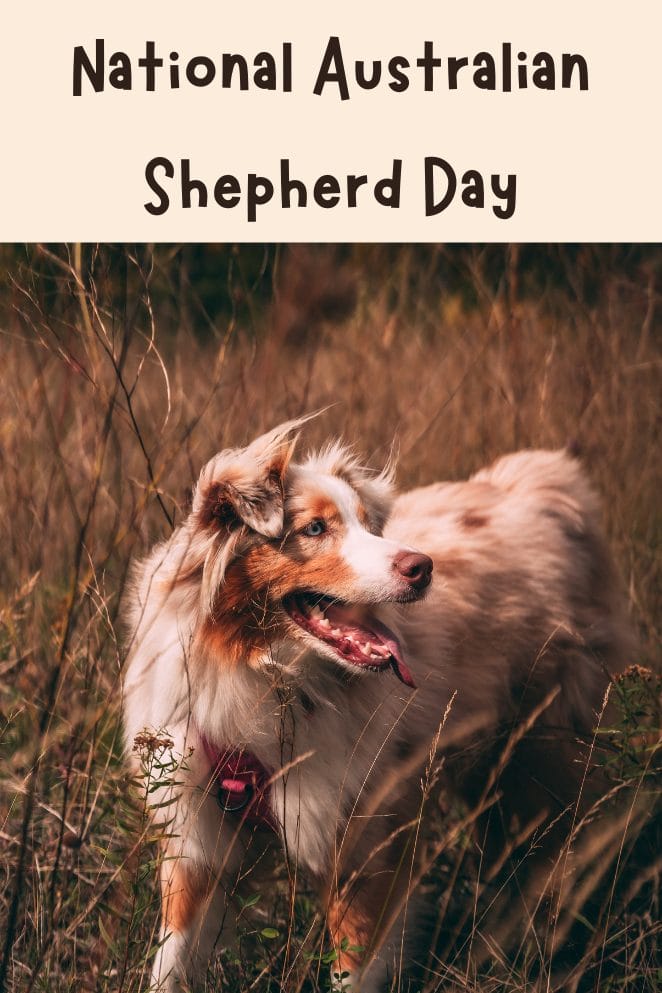
This year, on January 9, which is National Australian Shepherd Day, celebrate this amazing species.
On January 9, National Australian Shepherd Day, it’s time to celebrate your furry friends with a big celebration!
Enjoy the day with unique and enjoyable events, special outings that are more informal, and much more.
The Australian Shepherd is a canine of medium size, featuring a moderately lengthy double coat that may display a straight or wavy texture.
Renowned for their intelligence, energy, and loyalty, Aussies are inherently eager to please and demonstrate ease in training.
They exhibit excellent compatibility with children and other pets. Given their highly active nature, Australian Shepherds require ample exercise and prove well-adapted to engage in diverse activities, including agility, obedience, and herding
Originating in the United States, Australian Shepherds derive their name from ancestors that were originally brought to Australia from Europe.
Initially employed as herding dogs, they continue to exhibit robust herding instincts to this day.
Australian Shepherds earned acclaim among American ranchers for their outstanding herding skills, but their popularity soared beyond agricultural circles, thanks in part to their appearances in rodeos.
While their prowess in guiding livestock, particularly bulls, contributed to their renown, Australian Shepherds further endeared themselves to the public by showcasing a remarkable ability to execute a variety of tricks and manoeuvres.
Like all dogs, early socialization plays a crucial role in shaping the behaviour of Australian Shepherd puppies.
Quick Facts
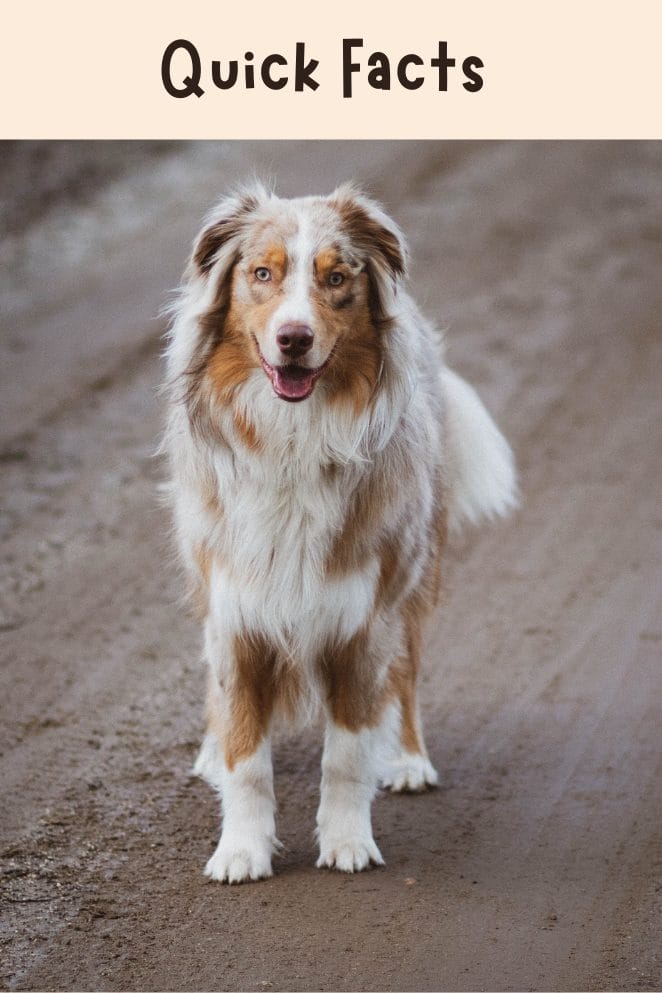
- Origin: Contrary to its name, the Australian Shepherd does not hail from Australia; instead, its origins can be traced back to the United States.
- Breed Group: Herding Group
- Size: Male Australian Shepherds typically stand between 20 to 23 inches (51 to 58 cm) tall at the shoulder, while their female counterparts are slightly smaller, ranging from 18 to 21 inches (46 to 53 cm). On the other hand, the Miniature Australian Shepherd is characterized by a height of under 18 inches, with a weight falling between 20 and 40 pounds.
- Lifespan: 12 to 15 years
- Coat: Australian Shepherds possess a double coat of medium length, which can exhibit either a straight or wavy texture. The coat is characterized by a diverse range of colours, such as black, blue merle, red, and red merle. Additionally, these coats often feature white markings and distinctive copper points.
- Temperament: Australian Shepherds are renowned for their high intelligence, boundless energy, and remarkable versatility. With a robust work ethic, they showcase loyalty and affection towards their families. While they may initially be reserved around strangers, Australian Shepherds are generally friendly and social once they become acquainted and warm up to individuals.
- Exercise Needs: Due to their inherently active nature, this breed necessitates regular exercise to maintain both physical fitness and mental stimulation. Daily walks, dedicated playtime, and engaging interactive activities are crucial to prevent boredom and promote their overall well-being.
- Training: Recognized for their quick learning abilities, Australian Shepherds excel in a variety of dog sports and activities. Early socialization and consistent, positive reinforcement-based training play a crucial role in fostering their well-rounded development.
- Grooming: Regular brushing is necessary to protect their coat from matting and to maintain its best appearance.
- Health: Although all breeds can be susceptible to some genetic health problems, Australian Shepherds are typically a healthy breed. Hip dysplasia, visual problems, and epilepsy are common concerns. A healthy lifestyle and routine veterinary examinations can help reduce these hazards.
Australian Shepherd History
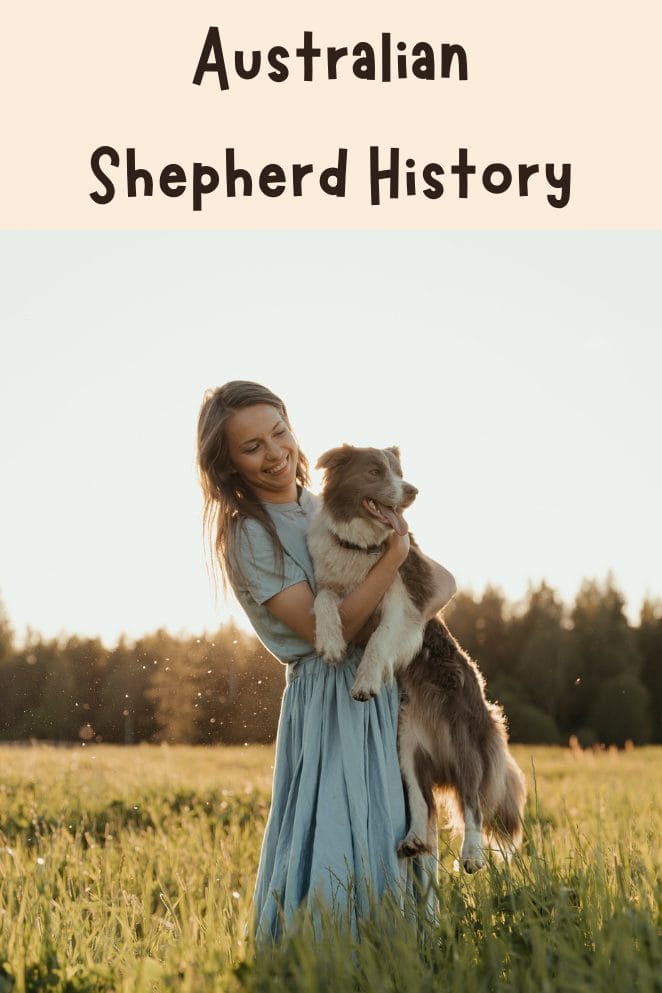
This breed, despite his name, is American in origin. In the western United States, ranchers and farmers used Australian Shepherds to herd livestock, and some of these dogs still work in that capacity today.
Numerous hypotheses exist on the breeds that influenced the development of the Australian Shepherd.
The name “Aussie” comes from the possibility that the breed’s progenitors were shepherd and collie dogs brought in with sheep shipments from Australia in the 1840s.
Breeders wanted to produce bright, hardworking, and flexible dogs, and they also wanted to improve their herding skills.
In the years following World War II, the breed had a surge in popularity that coincided with a resurgence of interest in Western-style equestrian riding.
The athletic canines that the cowboys used to work alongside them amazed the audiences at horse shows and rodeos as well as viewers of western films and television programs.
Even with the increased popularity, the American Kennel Club did not officially recognize the breed until 1993.
The striking, active, and intelligent Australian Shepherd of yesteryear is still the same breed that helped farmers and ranchers in the ancient West.
He is adored by many and leads a happy life as a herding dog, family friend, and guardian.
Decoding the Australian Shepherd Day in Detail
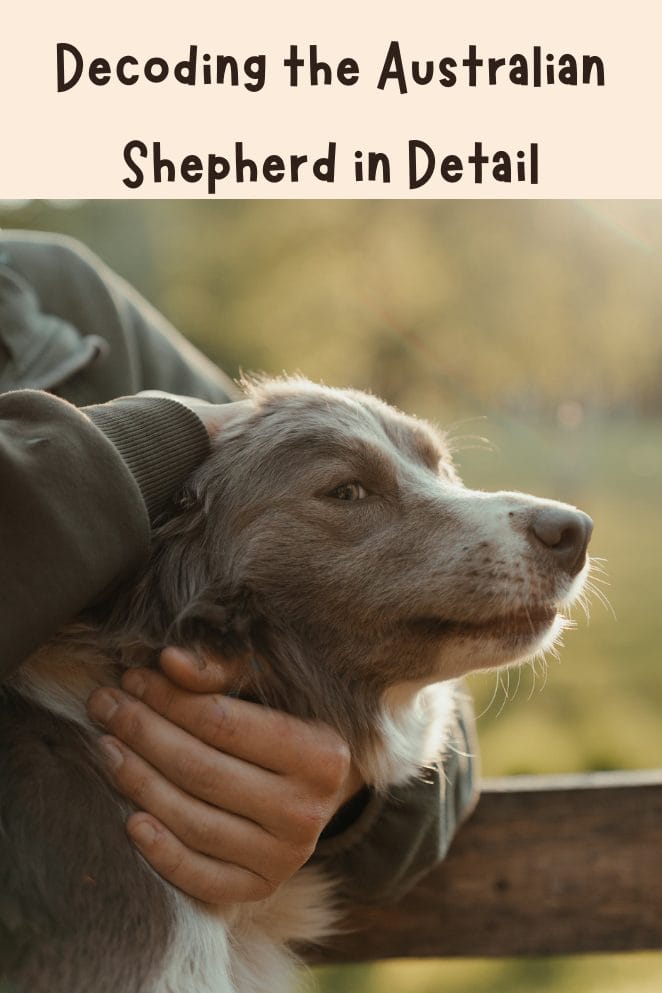
Appearance
The strong, medium-built dog that goes by the loving nickname “Aussie” is extremely bright and lively. They possess the ability to assess a situation, determine a reasonable path of action, and then take it. Their superiority in the field stems from these attributes.
The breed is easily recognized by its bobbed tail, which is hardly visible through the thick coat. The AKC standard states that the ideal tail length for adult Australian canines with docked tails is 4 inches, and this feature is recessive.
Coat and Grooming
The medium-length double coat of the Aussie is adorned with a fluffier collar, commonly called a “ruff,” that wraps across the neck, shoulders, and chest. Black, blue merle, crimson, and red merle are the colours of coats.
The breed sweats all year round, but in the spring when their winter coat blows off, it sheds more heavily. Australians do not have low allergens.
Brush the Aussie’s coat once a week, or more frequently during times of high shedding, to prevent matting. If you brush them frequently, your Aussie should only need a bath when they’re really filthy—which shouldn’t be more than a few times a year.
Make sure you choose a shampoo product that is suitable for dogs to prevent drying out their skin and coat.
Temperament
While the Australian Shepherd is an affectionate dog that can compete with the Energizer Bunny, it’s only normal for them to be a little shy around new people. Australians will do whatever it takes to keep an eye on and defend both their flocks and their human family. They have a strong sense of loyalty to both.
With the right socialization and training, Australian Shepherds are not usually aggressive that makes wonderful, loving family pets. Australians need to be socialized and exposed to a wide range of people, places, sounds, and activities, especially when they are still young.
Exercise Requirements
If there is a downside to the Australian personality, it is merely that they are naturally quite gregarious and have a strong urge to expend energy. This means that in order to keep your dog occupied, they may start engaging in destructive behaviours if you don’t give them enough exercise on a daily basis.
Your Aussie requires at least a little bit of exciting exercise each day, such going for a run, playing Frisbee, practicing agility, or obedience. When you’re not playing with them, interactive puzzle toys are a terrific method to keep their busy mind engaged and stimulated both mentally and physically.
Training
There’s no better combination than being eager to please and as sharp as a whip. Australians may be trained for practically any job, including housebreaking, farm work, and helping the disabled. These canines have the potential to become true masters of all trades if you are willing to invest the necessary time in them.
Positive reinforcement training, or reward-based training, has been shown to work well with Australian Shepherds.
Famous Australian Shepherds
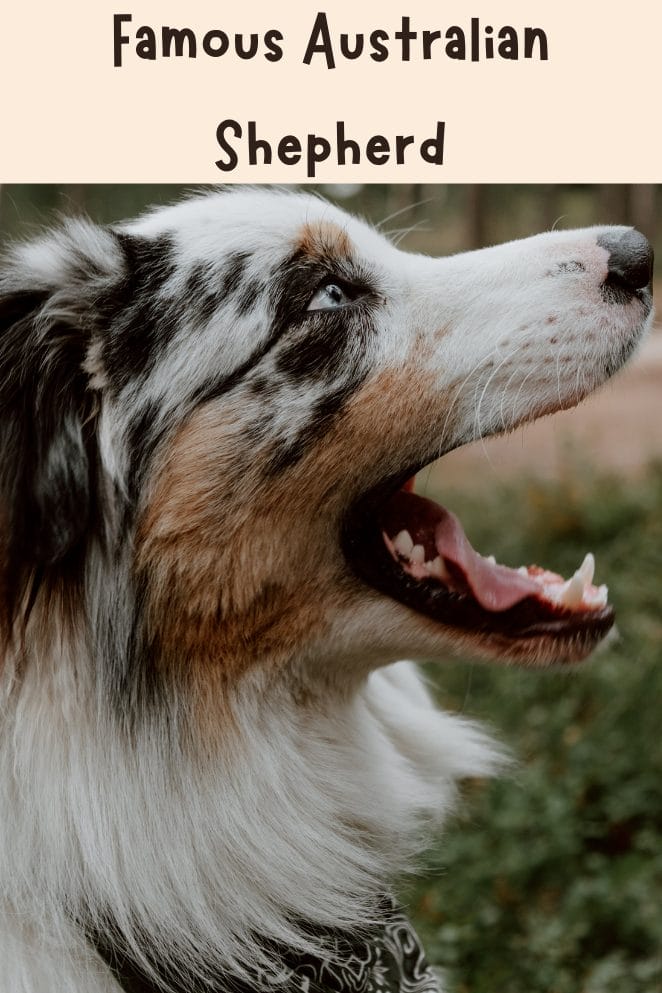
Australian Shepherds, often referred to as “Aussies,” are popular and well-known herding dogs.
While there may not be specific individual Australian Shepherds that are universally famous, the breed as a whole has gained recognition for their intelligence, versatility, and striking appearance.
However, I can provide you with some notable Australian Shepherds that have made an impact in various fields:
- Las Rocosa Australian Shepherds: Las Rocosa is a prominent Australian Shepherd kennel that has produced many successful dogs in conformation, herding, and other dog sports. Their breeding program has contributed significantly to the development and promotion of the breed.
- Slash V Australian Shepherds: Slash V is another well-known kennel that has consistently produced quality Australian Shepherds. They have bred numerous champions in conformation and working events.
- WTCH Hangin’ Tree Black Bear: Hangin’ Tree Black Bear is a highly regarded Australian Shepherd known for his exceptional herding skills. He achieved the highest herding title of “Working Trial Champion” (WTCH), showcasing his talent and versatility.
- HOF WTCH Windsongs Falcon Rising: Windsongs Falcon Rising is an Australian Shepherd that earned the prestigious title of “Working Trial Champion” and was inducted into the ASCA (Australian Shepherd Club of America) Hall of Fame. He excelled in herding trials and demonstrated his exceptional abilities.
- Chill’s Red Devil: Chill’s Red Devil, also known as “Devil,” was an accomplished Australian Shepherd who gained fame in the world of canine disc sports. He won several national and international competitions, showcasing his athleticism and talent.
Health Concerns

The Australian Shepherd has some health issues, just like many other dog breeds.
Among dogs nowadays, canine hip dysplasia is arguably the most prevalent condition. Ankle rubbing occurs when cartilage is overworked due to deformities in the joints.
For the afflicted dogs, this can be debilitating and excruciating.
Furthermore, Australians may be more likely to:
- Progressive Retinal Atrophy: A degenerative condition of the eyes that eventually causes blindness by destroying the photoreceptors in the rear of the eye.
- Hypothyroidism: A disorder when the thyroid gland fails to produce enough hormone.
- Cancer: Cancer can affect dogs in the same way that it impacts people. The effectiveness of treatment varies from case to case because there are numerous diverse kinds of cancer. There are several ways to control or completely eradicate cancer, including surgery, medication, and alternative therapies. When it comes to cancer, Aussies are more likely than other breeds to acquire lymphoma and hemangiosarcoma.
- Canine Epilepsy: Seizures are a neurological symptom of epilepsy. Medication can help control epilepsy, but it cannot be cured. A dog can live a long and healthy life if this genetic ailment is properly managed.
- Skin problems: Skin allergies are common in Australian Shepherds and are probably inherited. Allergen exposure, general exposure, upbringing, and genetics all play a part, though, just as with other dogs. If skin allergies are not addressed, they can cause severe harm to your dog’s skin, including hot spots and skin damage from constant rubbing, scratching, and biting.
- Nasal Solar Dermatitis: This condition, which is also referred to as “Collie-nose,” affects dogs—though not just Collies—whose noses have little or no pigment. Dogs that are photosensitive develop sores on their noses and even around their eyelids. These lesions can range in size from tiny pink pimples to ulcers.


GIPHY App Key not set. Please check settings